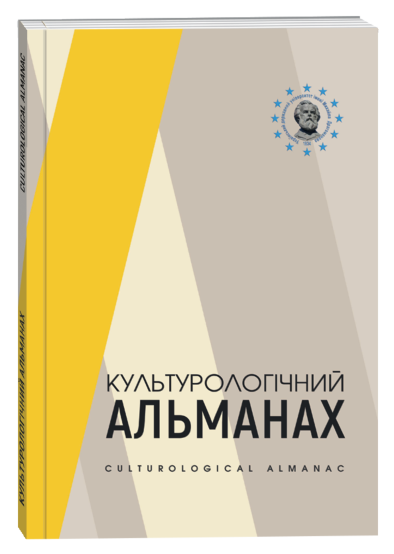PALAEOLITHIC MAN'S WORLD PERCEPTION: THE FORMATION OF A MYTHOLOGICAL WORLDVIEW
DOI:
https://doi.org/10.31392/cult.alm.2025.1.30Keywords:
Mythological worldview, Homo sapiens – Cro-Magnon (Abstract
The article examines the worldview of Paleolithic man and the formation of his mythological worldview in the conditions of the emergence and development of primitive society.It is noted that samples of Paleolithic art after Homo sapiens left East Africa allow us to determine the similarity of rock paintings even in regions deprived of the possibility of social contacts (for example, in Europe and Indonesia),as evidenced by the ability of primitive artists to observe proportions, convey volume using different colors, and useprotrusions and unevenness of the cave surface. Samples of cave painting are considered, which gave grounds to talk about the meaningfulness of the artists' cognitive activity, a high level of skill, their ability to think imaginatively,as well as to imitate samples of figurative art. It is emphasized that, according to the researchers conclusions, onlya person with a highly developed form of social consciousness and spiritual comprehension of the surrounding world could create such masterpieces.The role of artists in society as holders of a certain culture and spiritual power is characterized, in particular, guardiansof ancestral knowledge, keepers of magical social codes and secrets of creativity. Attention is focused on the presence of art workshops in the late Paleolithic period, on the basis of which the conclusion is made about the existence of traditions of apprenticeship in the transfer of one's own life experience and secrets of Paleolithic craftsmanship.It is determined that a characteristic feature of the spiritual culture of the Cro-Magnons was syncretism: it transformed with the development of man, but remained syncretic, that is, the beliefs of primitive man, economicactivities, social life, forms of consciousness and primitive art were inseparable. It is separately emphasized thata vivid embodiment of the syncretism of the primitive era is myth. Other features inherent in the mythological worldview of man of tribal society are also named.It is concluded that Paleolithic art is a form of social communication, a reproduction of the Cro-Magnon worldview in artistic images, and is a sign of the formation of a mythological worldview of a modern-type person, which later,in the process of socialization, will lead to the creation of orderly systems of myth, which, thanks to the emergenceof writing, will reach our days.Particular attention is paid to the characterization of the mythological worldview by Claude Lévi-Strauss. Thework also uses the results of research by Professor Joachim Hahn (University of Tübingen, Germany), Professors Maxime Obert and Adam Bramm of the Australian University, and researchers Simon Chiesen (University of York, Great Britain) and Christophe Delage (National Museum of Natural History, Paris, France).
References
Археологи зробили легендарну статуетку палеоліту на 8 тисяч років давнішою. (21.02.2013). Gazeta.ua. URL: https://gazeta.ua/articles/history/_arheologi-zrobili-legendarnu-statuetku-paleolitu-na-8-tisyach-rokiv-davnishoyu/483677
Бет Харріс, Стівен Цукер. (27.10.2022). 5.1:Палеолітичне мистецтво. Вступ до історії мистецтва I (Myers). Бібліотека LibreTexts. URL: https://ukrayinska.libretexts.org/Гуманітарні_науки/Мистецтво/Вступ_до_історії_ мистецтва_I_(Myers)/05%3A_Мистецтво_кам'яного_віку/5.01%3A_Палеолітичне_мистецтво
Клод Леві-Стросс. (1979). Міф та значення. Переклад Марії Маєрчик. Перекладено за виданням: New York: Schockenbooks. 107 с. URL: https://nz.lviv.ua/archiv/1995-2/10.pdf
Настя Горлиця. (15.06.2024). Альтаміра – Сікстинська капела печерного мистецтва. Expres.online. URL: https://expres.online/istoriya-plyus/altamira-sikstinska-kapela-pechernogo-mistetstva
Орест Горянський. (12.12.2019). Печерні люди. Археологи виявили найстаріший у світі наскельний живопис. Урядовий Кур'єр. URL: https://ukurier.gov.ua/uk/news/arheologi-viyavili-najstarishij-u-sviti-naskalnij-/
Carole Fritz , Gilles Tosello, Margaret W. Conkey. (2015). Reflections on the Identities and Roles of the Artists in Euro- pean Paleolithic Societies. ACADEMIA. URL: https://www.academia.edu/25717129/Reflections_on_the_Identities_and_ Roles_of_the_Artists_in_European_Paleolithic_Societies?nav_from=f35b61b2-9ad0-4b04-89d2-31f9c26f3802
Simone Chisena, Christophe Delage. (12.5.2018). On the Attribution of Palaeolithic Artworks: The Case of La Marche (Lussac-les-Châteaux, Vienne). Open Archaeology. 251 с. https://doi.org/10.1515/opar-2018-0015








